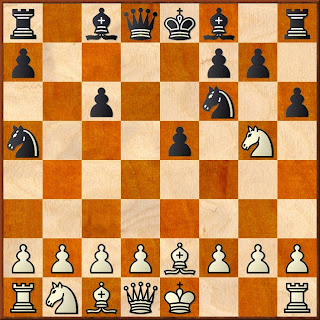The previous post was inspired by a couple of games in the Two Knights Defense, a highly interesting opening first mentioned (according to the German Handbuch) by the Italian author Polerio in 1590.
1.e4 e5 2.Nf3 Nc6 3.Bc4 Nf6
This move defines the Two Knights Defense. Steinitz described “this defense is in reality a counter-attack on Black's third move, which being so early instituted ought to be disadvantageous to the second player on principle.”
4.Ng5
Against the principle of not moving the same piece twice in the openings, the ‘violator’ must have a very good, if not excellent, preparation otherwise the game will again become an affirmation of that principle.
Siegbert Tarrasch called 4.Ng5 a "duffer's move" (ein richtiger Stümperzug) and Oscar Panov called it "primitive", but this attack on f7 practically wins a pawn by force. Despite Tarrasch's criticism, many players consider 4.Ng5 White's best chance for an advantage and it has been played by World Champions Wilhelm Steinitz, Bobby Fischer, and Garry Kasparov.
Max Lange’s 4.d4 will be a subject for future posts.
4... d5
The Chess Connoisseur maintains this is Black’s most reasonable reply.
5.exd5 Na5
Both 5...Nd4!? (Fritz,A) and 5...b5!? (Ulvestad,O) are interesting alternatives for Black. On the other hand the immediate recapture 5... Nxd5?! is dangerous for Black. White obtains the initiative after 6.d4! Likewise interesting is the sacrifice 6.Nxf7!?
Black's alternatives to 5...Na5, the Fritz Variation 5... Nd4, and Ulvestad's Variation 5... b5, are related as they share a common subvariation. American master Olav Ulvestad introduced 5... b5 in a 1941 article in Chess Review. German master Alexander Fritz (1857–1932) suggested 5... Nd4 to Carl Schlechter, who wrote about the idea in a 1904 issue of Deutsche Schachzeitung. In 1907 Fritz himself wrote an article about his move in the Swedish journal Tidskrift för Schack. White's best reply is 6.c3, when the game often continues 6...b5 7.Bf1 Nxd5 8.Ne4 or 8.h4.
The recapture 5... Nxd5?! is very risky. Pinkus tried to bolster this move with analysis in 1943 and 1944 issues of Chess Review, but White gets a strong attack with either the safe Lolli Variation 6.d4! or the sacrificial Fried Liver (or Fegatello) Attack 6.Nxf7!? Kxf7 7.Qf3+ Ke6 8.Nc3. These variations are usually considered too difficult for Black to defend over the board, but they are sometimes used in correspondence play.
6.Bb5+
After 5... Na5, Morphy would play to hold the gambit pawn with 6.d3. The Morphy Variation has not been popular, since it has long been known that Black obtains good chances for the pawn with 6...h6 7.Nf3 e4 8.Qe2 Nxc4 9.dxc4 Bc5. (Bronstein once tried the piece sacrifice 8.dxe4!? with success, but its soundness is doubtful.)
6… c6 7.dxc6 bxc6 8.Be2
The move 8.Qf3?!, popular in the nineteenth century and revived by Bogoljubov in the twentieth, is still played occasionally, but Black obtains a strong attack after either 8... h6! or 8... Rb8.
8… h6
White has a choice of retreat for the knight between the squares f3 (modern preference) and h3 (old preference). Which of them is best?
The Chess Connoisseur acknowledges and appreciates the various sources used in the preparation of this series.
(End of Part 1 of 3)
To be continued.
.
To be continued.


No comments:
Post a Comment